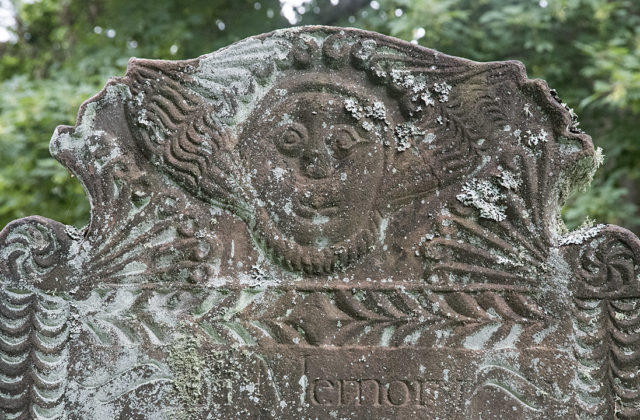Historical Gravestones Offer Hints About Past Lives
Tales from the Old “Buryal Yard”
By Ryan Bachman
Walking through an old graveyard can be like stepping back in time. The strange designs and archaic language carved on historic gravestones can tell little known and unusual facts about the history of a community and its residents. Two hundred and sixty years ago this past February, Norfolk voters established the town’s first cemetery. The old “buryal yard,” as it was then called, formed the core of today’s Center Cemetery on Old Colony Road. As the settlement grew, more graveyards were set up in areas like Grantville in the southeastern corner of town.
The English families who settled Norfolk brought with them specific ideas about mortuary art. Even as late as the mid-1700s, New England grave art was still largely defined by Puritan concepts. Most notably, Puritans and their descendants did not believe in putting overtly religious symbols, such as crosses, on grave markers. Instead, they decorated their stones with more abstract symbols of death. By the time Norfolk was incorporated, the best known of these symbols was a face with wings, commonly known as the “cherub” design. The winged face was thought to represent the flight of the soul into the afterlife and is one of the most popular motifs found on Norfolk gravestones from the middle to late 1700s.
When Michael Humphrey passed away in early 1778, his family chose the fashionable cherub design to adorn the top of his gravestone. Humphrey, a former Congregationalist deacon and tanner, is buried in the oldest section of the Center Cemetery, near a collection of crooked, lichen-covered stones that similarly bear cherub carvings. At first glance, Humphrey’s memorial looks almost identical to the surrounding stones. On closer inspection, however, his stone may be a rare example of an 18th-century caricature.
Many stone carvers used generic patterns for the faces they etched in stone, but one body of research suggests that carvers sometimes customized their designs in order to create caricatures of the deceased. If someone had a distinctive look in life, such as a specific hairstyle, research suggests that stone carvers sometimes altered their memorials accordingly.
In the case of Michael Humphrey, the face on his stone appears to be wearing a beard. His is the only Norfolk gravestone with this particular detail, which suggests that he may have worn long whiskers in life. A beard in colonial Connecticut would certainly have been distinctive, as beards were seen as unfashionable, and even inappropriate, by most New Englanders at the time. The face carved on Humphrey’s stone may reveal what this 18th-century Norfolk resident looked like.
Four decades after Humphrey was laid to rest, Lodama Case was buried in Grantville Cemetery. Case’s tombstone is interesting not so much for its design but for the unusual nature of her epitaph. Epitaphs are the phrases found near the bottom of gravestones which let grieving families choose how their loved ones will be remembered by future generations. Most of these emphasize how beloved the deceased has been in life—phrases like “loving mother” or “dear wife” are common on many markers. Case’s epitaph, on the other hand, hints at the social conditions that women faced in Norfolk at the time.
After Case died from an accidental poisoning in May 1822, her husband, Aaron, commissioned a gravestone that blended contemporary styles with more traditional ideas about gender. By the 1820s, the cherub design found on Michael Humphrey’s stone had been all but replaced by carvings of urns and willow trees. This new style was associated with ancient Greece and was part of a larger American fascination with that classical civilization. Like many other 19th-century stones that dot the hillside of Grantville Cemetery, Case’s stone depicts an urn sitting beneath a weeping willow.
While the image found on Case’s stone was common for 1822, her epitaph recalls an earlier era. Instead of immortalizing Lodama as a dear wife or mother, Aaron chose an epitaph that read: “No slander dwelt upon her tongue.” Although this may seem like a strange trait to emphasize on a tombstone, it makes sense when considered within the larger history of the region. Slander was one of the most common crimes tried in colonial times and was thought to be an inherently negative female trait. By celebrating his wife’s aversion to slander, Aaron immortalized her character and left a permanent historic record of how colonial ideas about women and slander lingered on in 19th-century Norfolk.
Photo by Bruce Frisch.


I’ve always been fascinated by grave markers. I was wondering was this originally a cemetery or a graveyard? If so, which church did it belong to? Also, was there a particular stone that was traditionally used?